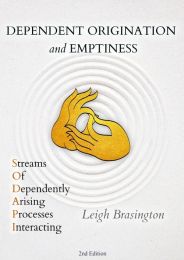 |
|
|
Appendix 5
Is the Realm of the Asuras an upper or lower realm?
Someone asked the following question:
In the chapter The Wheel, you say, "Among the lower realms is also the realm of the warring gods, the Asuras. These are beings that are fighting all the time." Yet in the picture of the Wheel of Life the Asuras are in the upper part of the wheel. Isn't the Asura Realm one of the upper realms?
As is so often the case, it depends on whom you ask. Remember this is mythology rather than any sort of scientific fact. Consider the following:
- It appears one sutta, from thousands, namely, Iti 93, includes a separate asura realm and places asura below hungry ghosts.
Being unaware of these three fires, humankind (paja = people) delights in personal existence.
Unfree from the bonds of Mara They swell the ranks of hell, existence in the animal realm, asura-demons and the sphere of ghosts.
Iti 93
Therefore, based on Iti 93, the descending order is:
- Deva gods
- Humans
- Hungry ghosts
- Asura gods
- Animals
- Hell
https://buddhism.stackexchange.com/questions/44258/whats-the-ordering-of-6-realms-of-rebirth
- Whereas the devas (“gods”) dwell in the heavenly realms and are basically benevolent, the asuras (“not-gods”) are opposed to the devas and locked into continual struggle with them.
(My bold) https://personal.carthage.edu/jlochtefeld/buddhism/wheeloflife/sixrealms.html
- According to the mythology, When a deva’s time in the Heaven Realm is ending, he or she is plagued by a subtle but growing sense of dissatisfaction. The deva may react to this with fear of loss and subsequently begin to foster a sense of paranoia and jealousy. From this point on, every loss is taken as a confirmation of the need for fear, and the good fortune of others is seens as a threat in a new realm where limited resources are the preeminent concern. The deva then loses the Heaven Realm and is reborn in the Realm of the Asuras.
(My bold) https://zenstudiespodcast.com/sixrealms2/
Beings in Hell. Naraka-gati in Sanskrit. Jigokudō 地獄道 in Japanese. The lowest and worst realm, wracked by torture and characterized by aggression.
Hungry Ghost. Preta-gati in Sanskrit. Gakidō 餓鬼道 in Japanese. The realm of hungry spirits; characterized by great craving and eternal starvation.
Animals. Tiryagyoni-gati in Sanskrit. Chikushōdō 畜生道 in Japanese. The realm of animals and livestock, characterized by stupidity and servitude.
Asura. Asura-gati in Sanskrit. Ashuradō 阿修羅道 in Japanese. The realm of anger, jealousy, and constant war; the Asura (Ashura) are demigods, semi-blessed beings; they are powerful, fierce and quarrelsome; like humans, they are partly good and partly evil. See Hachi Bushu (8 Legions) for details.
Humans. Manusya-gati in Sanskrit. Nindō 人道 in Japanese. The human realm; beings who are both good and evil; enlightenment is within their grasp, yet most are blinded and consumed by their desires.
Deva. Deva-gati in Sanskrit. Tendō 天道 in Japanese. The realm of heavenly beings filled with pleasure; the deva hold godlike powers; some reign over celestial kingdoms; most live in delightful happiness and splendor; they live for countless ages, but even the Deva belong to the world of suffering (samsara) -- for their powers blind them to the world of suffering and fill them with pride -- and thus even the Deva grow old and die; some say that because their pleasure is greatest, so too is their misery.
https://www.onmarkproductions.com/html/six-states.shtml
- The placement of the asura realm in Buddhist cosmology varies among traditions. Sometimes the asura realm is recognized as one of happiness, existing beneath the worlds of the devas and humans. In other schemes, it is viewed as a fourth addition to the usual three evil paths that make up the animal realm, ghost realm and hell realm.
(My bold) https://en.wikipedia.org/wiki/Asura_(Buddhism)
While researching this, I also found multiple sources with the Asuras placed as an upper realm, particluarly in Tibetan teachings.
So it seems the suttas consider the Asura Realm one of the lower realms, as do (at least some) Zen teachings, while most Tibetan teachings do indeed place the Asuras above humans in a demi-god realm. Take your choice - after all it is mythology. But for me, any place where there is always "anger, jealousy, and constant war" is a lower realm!
|
|